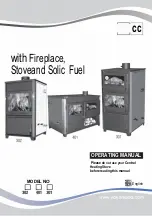
Page 15
IH (NA) R4 201102
The resulting residue that sticks to the inner walls of the chimney is called
creosote. Creosote is formed by unburned, flammable particulates present in
the smoke. It is black or brown in appearance. It can be crusty and flaky, tar-like,
drippy and sticky or shiny and hardened. Quite often, all forms will occur in one
chimney system.
The chimney and chimney connector should be inspected at least once every
two months during the heating season to determine if creosote build up has
occurred. If creosote has accumulated, it should be removed to reduce the risk
of a chimney fire.
If the wood you are using is water logged, or green, the fire will tend to smoulder
and not warm the chimney sufficiently. Wet wood causes the whole system to
be cool, and inefficient. In contrast: dry wood means a hot fire, which results in
a hot flue, and a hot flue means much less creosote clogging up your chimney.
The cook stove’s firebox is designed to operate at very high temperatures to
burn the gases and particles released from the wood, which means less air-
pollution.
Charcoal
When most of the tar and gasses have burned, the remaining substance is
charcoal (ash in it’s finer form). A hot bed of charcoals and ash can enhance the
combustion process when burning larger pieces of wood. Start with a small fire
to develop a bed of glowing embers. As the charcoal bed develops and the cook
stove heats up, slowly add larger and larger pieces of wood. It takes time to build
a good charcoal bed, but it is well worth the effort. Only empty excess ash
periodically and always leave a bed of ash on which to light the next fire. When
wood burns it gives off volatile gases which contain calorific heat value.
Peat
Peat is a fuel conveniently available in some areas and should be burned in the
same manner as wood.
Ash Removal
Wood burns best on its own ash and a manageable layer of ash on the grate is a
benefit to the efficient running of your cook stove. To empty the ashes from the
ash pan below the grate, open the door at the bottom left of the cook stove
using the Operating Tool by connecting the tool to the door handle and turning
counter-clockwise. Insert the tool into the slot on the ash pan and pull forwards
Summary of Contents for Ironheart EW
Page 39: ...Page 39 IH NA R4 201102 ...
Page 42: ...Page 42 IH NA R4 201102 ...
Page 43: ...Page 43 IH NA R4 201102 ...
















































